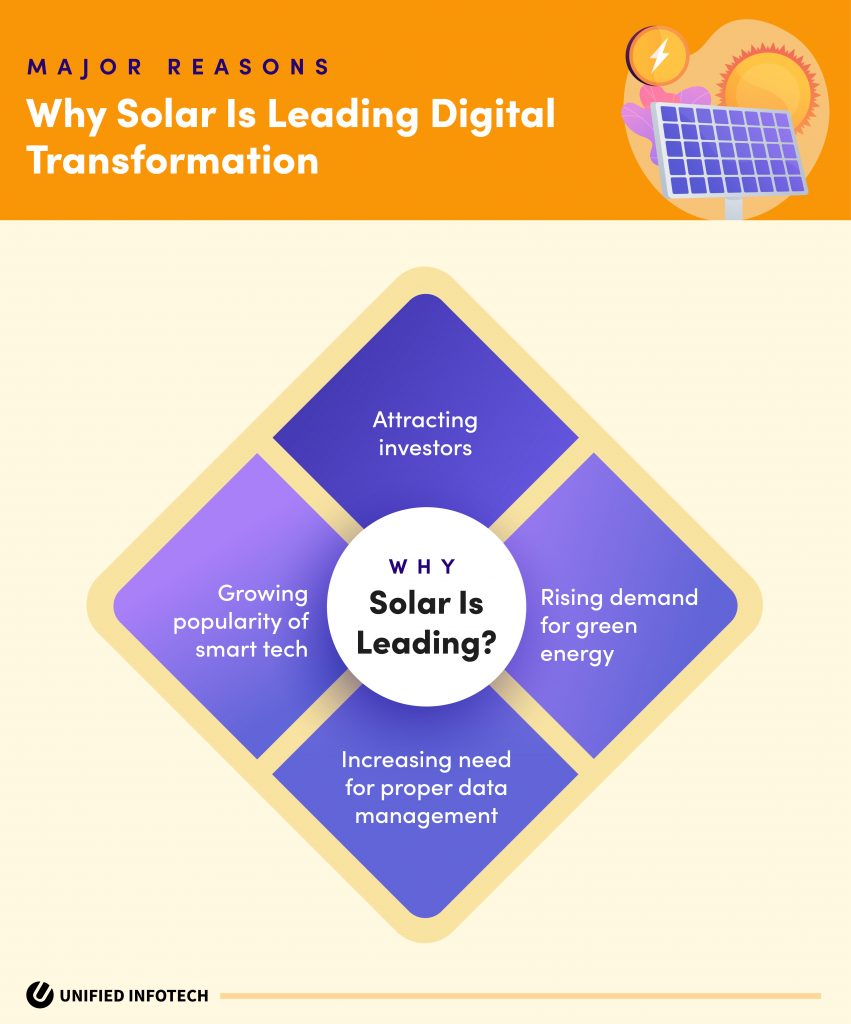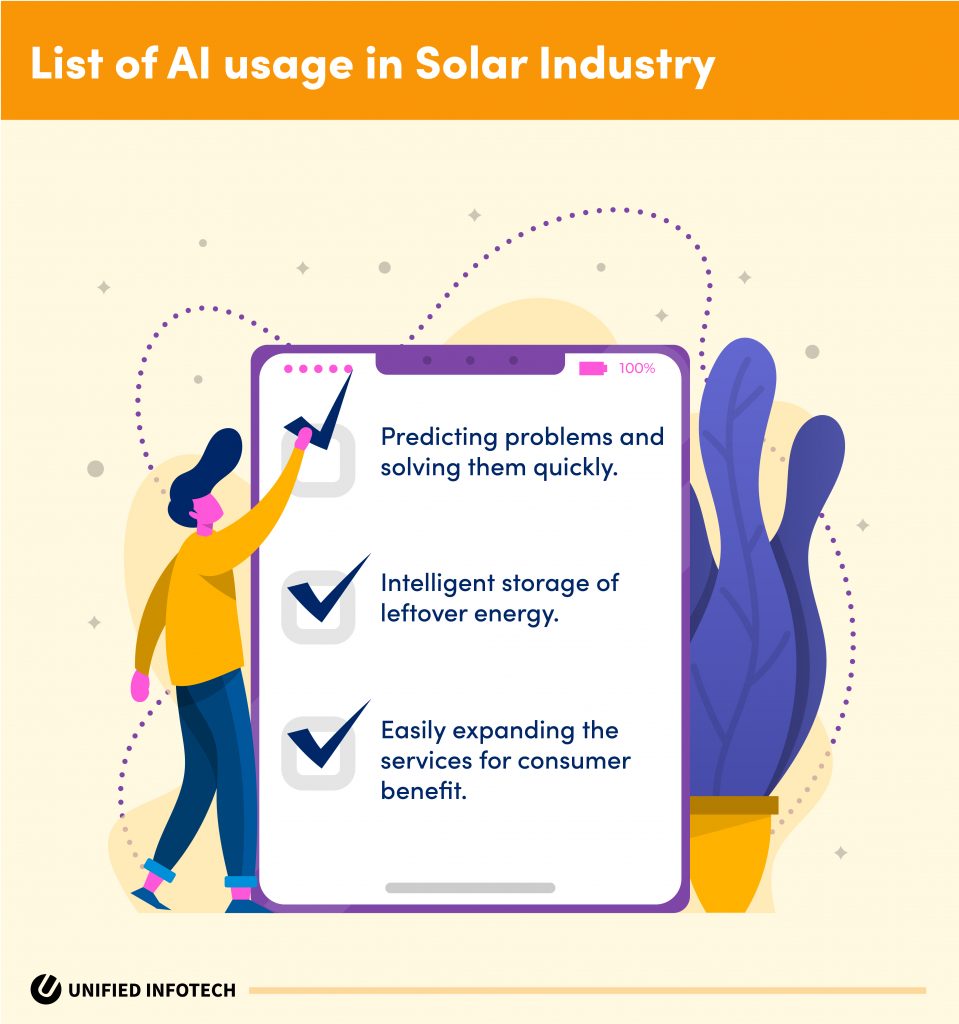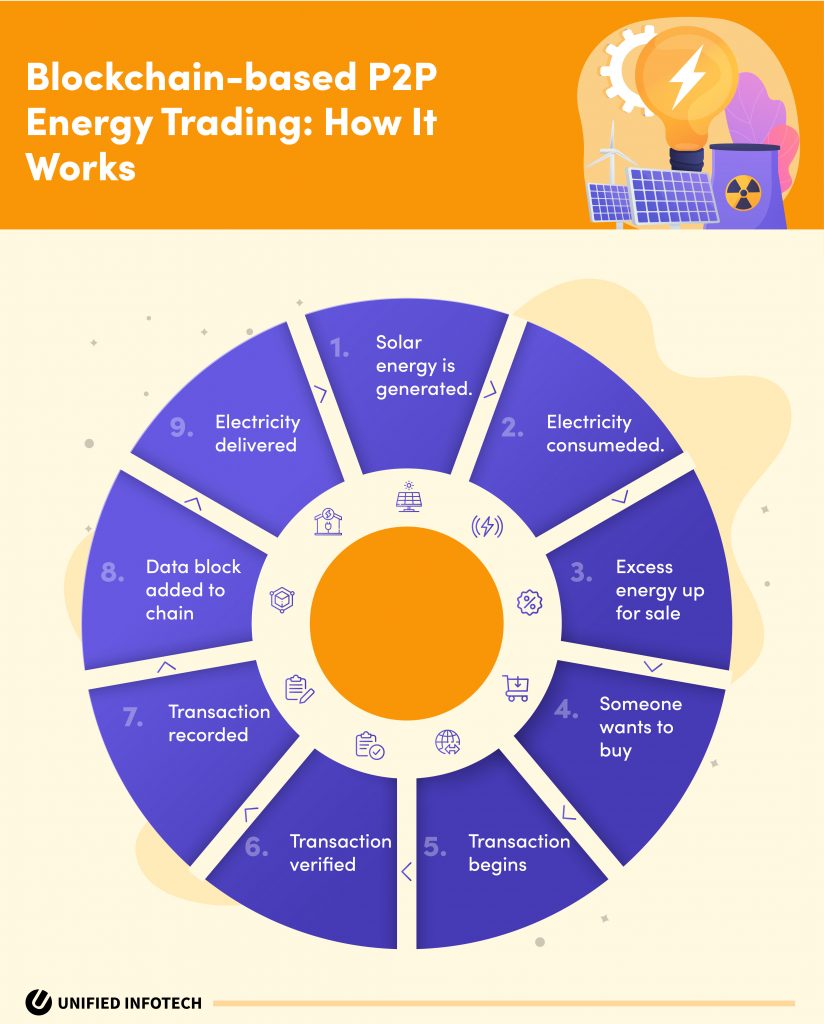Unlock Expert Advice with Zero Commitment.
We’ve Eliminated the Barriers.

“We are star stuff harvesting sunlight.” – Carl Sagan
From the very beginning, human beings have wondered about the sun. Despite being 147.21 million KM away from it, we have always been aware of its immense power. And that is why as soon as we had the necessary technology available, we began harnessing its power.
In the past decade, the solar industry has seen some remarkable changes. And a lot of these changes have been due to the fast-tracked digital transformation of the energy sector. However, it is the solar industry that is taking the lead in going digital.
But why is that?
Intrigued by this, our teams of DX experts conducted some in-depth research. Let’s see what they found, shall we?
Many reasons drive the transformation in the solar industry. However, our in-depth research has uncovered some exclusive factors that encourage this change.

If you are a part of this industry or thinking of becoming one, then read on. This list will help you understand what drives the rapid digital transformation in the solar energy industry.
The invested amount in the solar industry reached a staggering 141 billion US dollars in 2019. Being a part of an industry that is growing at a CAGR of over 17% during 2020-2025 is not easy. And the only way to succeed is to keep up with the advancement of the digital age.
The fact is that effective digital transformation in solar energy utilities attracts more investors. And that’s why everyone in the industry is focusing on digitizing their services. And this is a perfect solution if your want to improve and scale your business with proper investment.
Many countries across the globe are testing smart home initiatives and taking it up a notch to smart cities. And this is causing a rise in the need for eco-friendly energy solutions. And the solar industry is gearing up to fulfill this rising demand.
Entrepreneurs are putting more digital transformation efforts into their business to leverage this new chance. Adjusting the solar power services with smart technology will help them to become part of this advanced market. This smart power consumption trend is one of the main factors boosting digital transformation in the solar industry.
The sun might be the source of the purest energy in the world. But harnessing this energy is still hampered by legacy infrastructures and technology. This is why industry experts are concerned with the digital transformation needs of the solar energy sector.
With the advanced solutions, the industry is striving to keep up with the high demand for solar energy. Technology such as AI, IoT & blockchain, is helping to reduce operations cost and elevate the current state of the industry. The rising demand and the need for catch up are driving this rapid transformation process.
The solar industry is evolving fast. And as the industry expands, its data management needs are also growing rapidly.
Entrepreneurs are pushing for advanced digital transformation strategies because of the need for improved data management. Through the use of various hardware and software initiatives, organizations are gathering relevant data. This data is later sorted and analyzed to generate insight that helps the organization to grow.
There are many drivers of digital transformation in the power sector. These trends are speeding up the industry’s growth and helping to meet the demand for eco-friendly energy around the world.
If you are wondering what trends YOU must know about to advance in this industry, then here’s a list. It contains all the major digital trends that are changing the solar industry for the better.
The far-reaching nature of AI makes it one of the biggest drivers of successful digital transformation in the solar industry. The use of AI solutions in the business process are diverse, but here are some of the most popular ones-

For a solar power company, the chances of success depend on their on-field equipment. The equipment needs good maintenance to work well. And this is where AI/ML comes in.
With automated insight, it is easy to catch problematic issues fast. An AI-based advanced digital transformation plan helps to predict failures and technical issues. The prediction based feature also helps to automate and regulate the necessary responses.
This ability to predict and solve problems makes it easy for the company to remove any bottlenecks and improve equipment maintenance. So if you are looking to automate the energy harvesting process for your organization, take a look into AI solutions.
Sustainable energy sources can be unstable. The seasonal effect on the collection and supply of solar energy causes some serious issues when the energy demand is high. And simple storage solutions are not enough to handle a crisis this big.
And that’s why AI is an ideal solution for the digital transformation of solar energy management and automation. The use of automated software makes storing and supplying energy easy. This increases the efficiency of your business operation and helps to keep up with the high demands.
AI makes it easy for the industry players to grow their services. The diverse use of synthetic intelligence helps entrepreneurs to invent and reinvent the existing solutions. With advanced analytic and predictive benefits, you can optimize the digital transformation roadmap and provide better solutions to your audience.
With the use of AI, expanding the market reach is a much smoother process than before. And that’s why industry leaders are constantly trying to integrate it within their business process.
At this point, we are all familiar with the concept of distributed/decentralized database, a.k.a blockchain. Popular for its bitcoin application, blockchain is now changing the solar industry as well.
Until now, there have been two breakthroughs in the use of blockchain in the solar industry. The first one being easy P2P trading of energy. And the second one being the reduction of fraud in the corporate trading of solar energy. Let’s look at these in details-
One of the significant breakthroughs is blockchain’s use for P2P power trading. And the blockchain experiment, funded by the Australian government proved this. With this process, homeowners were able to sell the leftover energy produced from the domestic solar fixtures in a localized manner. They were able to set their price and trade at will.

Despite the negative sides, such as irregular prices set by individuals, this method has proven to be worthy. With this digital transformation method, individuals can now settle their funds faster. Earlier they would have to wait a certain period of time for their electricity bill and feed in traffics to settle. Now with blockchain, that process can be done almost instantly.
Additionally, the ability to release tokenized funds upon meeting specific terms is another great benefit of this technology. The use of blockchain will help you to remove transactional friction easily for the solar organization. So don’t forget to pay attention to blockchain benefits when planning a transformation for your organization.
Corporate accountability is pushing companies to be more eco-friendly. As a result, more business leaders are trying to implement solar solutions in the business process. However, the use of clean electricity does not always mean eco-friendly. And that’s why solar companies are using blockchain certification for every unit of energy they sell.
With the use of blockchain, solar power suppliers and corporates are building a transparent business relationship. Solar companies are using blockchain to provide a smart contract with every unit of power a big corporate buys. This way buyers can validate the certificate of origin. This use of blockchain in the solar digital transformation will help you fulfill the business objectives of going green.
Unlike the traditional energy sector, the solar industry needs to use remote methods to generate energy. Most of their main pieces of equipment are usually on the field, facing the best and worst of nature. However, the IoT applications in the solar energy sector make equipment maintenance a lot easier.
The positive impact of IoT on the energy sector also includes reducing the complexity related to power grids. The cloud-based data gathering process helps to monitor various on-field gears in real-time. You can access the data from a centralized control panel easily, and take necessary actions. The IoT collected data can also be used for advanced analysis and preservation.
The solar industry may have a lead on the transformation efforts compared to other energy sectors. But it is nowhere near completing that journey.
The legacy operation & management systems that are still in place for many organizations are hindering growth. Any of the advanced trends described above cannot function within the old framework. And that’s why industry leaders are partnering up with software development companies to profit from the advanced software trends.
The advanced solutions are created to improve business processes. This way organizations can perform real-time monitoring of their equipment, gather data from diverse sources, and deploy necessary actions. Additionally, the centralized nature of the software also makes it better for improving in-house teamwork.
Lastly, the diverse data management process is streamlined with a centralized custom software approach. Besides better security, it also makes the use of big data and AI analytics in energy and utilities digital transformation easier.
Over the past years, consumer engagement has changed. And to cope with the rising demands, solar organizations must tap into the world of advanced development & design technologies.
Proper website design & development is a crucial part of the digital transformation journey. It helps you to reach a diverse range of consumers out there. This enhanced reach will also help the business scale and increase the ROI.
Additionally, having a good website is crucial to connect to the audience. This way, you have a chance to educate the people out there about solar energy and its possibilities. From both a corporate and social perspective, it makes sense if you focus on the branding and web development process as well.
The solar industry has come far in terms of being digital. So here’s an example of how we helped one of our clients with their digital transformation efforts during COVID-19.
Our client wanted their website to reflect the latest technology they use to serve the clients. And that’s why they wanted the digital product transformation process to include the latest technology available in the market.
When our experienced team was approached with these requirements, they knew exactly what to do. Our solutions were tailored to fit our clients and fulfill the challenges the project presented us with. Take a look at their website.
Here’s a brief look at all the challenges and the solutions we deployed to solve them:
Challenges |
Solutions |
| The older website was not able to reach a wide range of audiences. | Through responsive design and development, we ensure their website was accessible from every device. |
| The presence of high-value competitors made it hard for our client’s to make their spot in the market. | We followed the latest design & development trends. This ensured that the website can compete with market rivals easily. |
| Managing content and updating it regularly was not easy. | With CMS, we created a backend panel that makes website content management easy. |
| The website was suffering from hard to understand niche market-related content. | We crafted a content strategy that is easy for the users to understand. |
With an Agile sprint method, our design and development teams began the process of transforming the website. The goal was to create a platform showcasing the digital efforts of our clients. Besides that, the website also needed to display the diverse range of services provided.
Keeping up with the digital transformation trends in the Solar energy industry is tricky. The landscape is experiencing lightning-fast changes, and you need expert help to keep up with that. So if you feel the need for assistance, let us know! Our in-house teams of experts are always ready to help.
We’ve Eliminated the Barriers.
We stand by our work, and you will too.